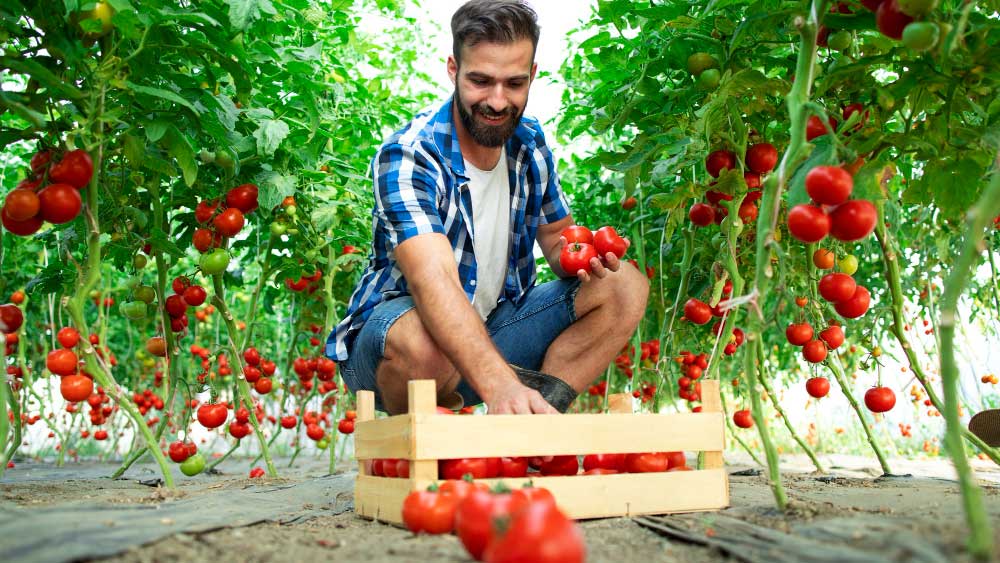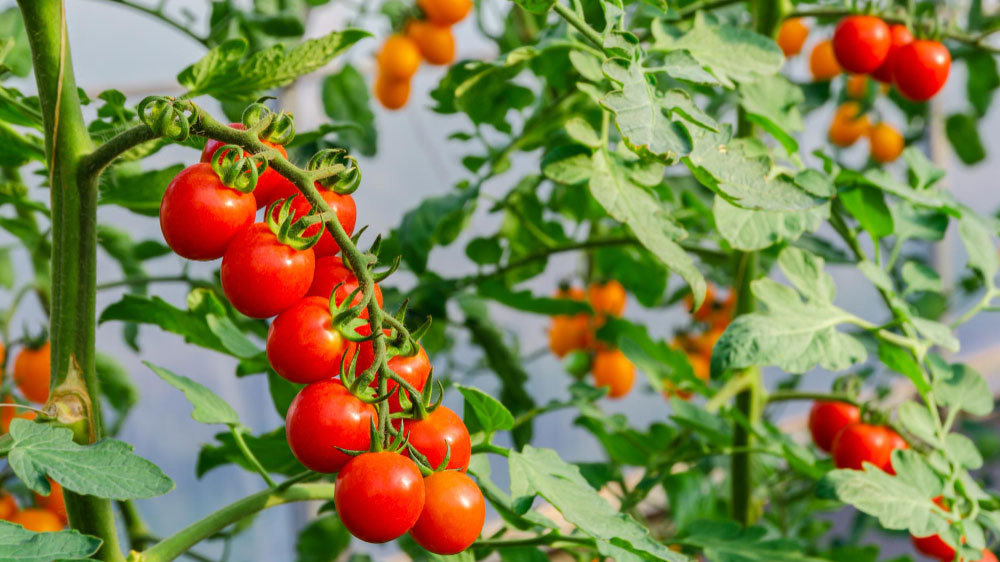Determinate vs Indeterminate Tomatoes: Choosing the Right Type for Your Garden
All tomato plants are vines but divided into two categories based on their growth habit: determinate and indeterminate. The duration and growth pattern of the plants are the main ways to differentiate between these two types. And once you know these characteristics, it is easy to tell them apart. Your choice between the two will depend on usage, available space, and the length of your growing season.
In this blog, we will guide you further into understanding the benefits of both determinant and indeterminate types of tomatoes and how to successfully grow to their full potential.

Differences Between Determinate vs Indeterminate Tomatoes
Determinate tomatoes: This type will stop shoot production once the flowers form on the ends. They are planted and fruit early on in the season and, as such, tend to be planted before the indeterminate types.Indeterminate tomatoes: Will continue growing until weather or cold temperatures no longer suit. This type produces flowers along the sides of the shoots, producing fruits until the end of the growing season.
| Characteristic | Determinate Tomatoes | Indeterminate Tomatoes |
|---|---|---|
| Growth Habit | Bushy, compact | Vining, tall |
| Height | 3-5 feet | 6-12 feet |
| Fruit Production | All at once | Throughout the season |
| Pruning | Optional | Recommended |
| Support | Basic support for the central stem, such as staking | Trellising needed to support long vines |
| Best for | Gardeners with limited space or who want to do preserves (sauces and pastes) | Gardeners with sufficient space who want tomatoes throughout the season |
Growth Habit and Plant Size
Start by considering natural characteristics. Determinate tomatoes are more compact, almost like a tomato shrub. They grow to a certain point and stop, making them a perfect choice for smaller spaces or containers.
In contrast, Indeterminate tomatoes will grow rapidly and resemble a vine. These plants need more space to climb and will need sturdy support to grow effectively.
Harvest Period and Yield
Determinate tomatoes set fruit over a few weeks, and then they’re done. Perfect if you’re growing for canning, jarring or making sauce in quantities and want to harvest within a shorter period of time. For this reason, most commercial sauces and soups are made from determinate tomatoes. Once the plant stops producing fruit, it will begin to die.
Indeterminate tomatoes produce fruit throughout and until the end of the growing season, when the temperatures drop low enough for frost, and there are fewer daylight hours. The advantage of continual growth is that the fruits ripen at different stages, prolonging the harvesting season.
Space Requirements and Support Needs
Determinate tomatoes are low-maintenance, and as they are more compact, they don’t need as much support. A small tomato cage or supportive cane should suffice.
Indeterminate tomatoes, in contrast, will require either a tomato cage at least 4ft high or a solid stake or cane to support its natural sprawling habit. In addition, the stems will require regular tying to the support system.

How to Choose the Right Type for Your Garden
If you live in an area with a short growing season, or want to grow tomatoes primarily for making quantities of tomato sauces, soups, pastes, etc, then determinate varieties are a better choice.
However, if you want to eat fresh tomatoes throughout the growing season, then indeterminate varieties will offer you a wide range of choices.
Consider Your Space
Determinate varieties can be successfully grown in pots on a patio or balcony or three to a vegetable grow bag. As they are usually an early season type, after harvesting, the site can be cleared to make room to grow another kind of vegetable. There are varieties of determinate tomatoes that are suitable for growing in the ground as well as undercover.
If you have more vertical space, then indeterminate types with their longer fruiting season are the perfect choice. Again, some varieties are suitable to be grown in the ground, though I have grown these types under cover in large pots or two planted in a vegetable grow bag.
Think About Your Tomato Goals
If you are planning to make large batches of homemade tomato sauce or salsa, then determinate tomatoes will give you a bumper crop, all within a short harvesting time of approximately two weeks.
But if you love the idea of fresh tomatoes for your salads and sandwiches all season long, go for Indeterminate types. They’ll keep your kitchen stocked with fresh tomatoes for months.
Care and Maintenance
If you prefer low-maintenance gardening, determinate varieties are the ideal choice. They only require moderate support, and with some basic care, you will be guaranteed a successful harvest.
However, extra care and maintenance will be required for indeterminate tomatoes as they will require sturdy support, pruning and tying in to provide a continued harvest.
Both determinate and indeterminate types of tomatoes will require adequate watering. It is absolutely essential not to underwater or overwater tomato plants but to keep the soil moist, free draining, and not water-logged. Watering directly to the roots is advisable, as this will also prevent any leaves from becoming sunscorched by overhead watering.
Ensure to include nutrient-rich soil in the planting hole if growing in the ground or use purpose-bought potting soil if using containers. Adding drainage materials, i.e., perlite if your soil is heavy or vermiculite if your soil is dry, along with well-rotted organic matter, is advisable. Vegetable grow bags usually have a well-balanced mix of nutrients and soil composition to give your plants a good start.
Using a purpose-bought tomato fertilizer is the best choice as it will have the best ratio of phosphorous and nitrogen to encourage flowering and fruiting as opposed to foliage growth.
All tomatoes require at least eight hours a day of direct sunlight, although some shade in the afternoon is advisable in hotter regions, especially if growing under glass. Take care not to water the foliage during sunlight hours, as this could cause the foliage to scorch and die back. Early morning or evening is the best time to water, especially during warm periods, as there will be less evaporation and more water will find its way to the roots.
Pruning
Determinate varieties generally don’t need any pruning. However, a stronger main stem can be encouraged if suckers that develop below the lowest flower set are removed.
Indeterminate varieties will produce suckers that grow out of the axils where the leaves grow from the stem. By removing these suckers, more energy will go into producing fruit as opposed to leaf growth.
Common Pests and Diseases
Aphids: These will be the most common pests you will probably have to deal with and are best treated by using an organic or non-organic herbicide specially formulated for edible crops. A natural method is to spray of the aphids with water, but not during strong sunlight. Or remove aphids by hand, which is not particularly pleasant and is time-consuming, so it is best to inspect regularly and act immediately. Attracting ladybugs into your garden is another natural solution.
Whitefly: Suck the sap, weaken the plant and stop fruit yield. Signs are yellowing leaves. The best cure is to keep your tomato plants healthy in the first instance, as whiteflies usually move onto other plants according to the environment.
Cutworms: There are several types, and they feed on the stems, cutting off water and nutrients to the plant. Look out for stems that have come away at base level and remove any sign of the cutworm by hand. Prevent by collars around seedlings or young plants to prevent cutworm larvae from feeding on the plants. In open ground, after harvesting, till the soil thoroughly to destroy overwintering cutworms. For containers, dispose of the soil if possible or turn it over and leave it for the birds to pick at.
Luckily, most tomato plants these days are hybrid types that have been specifically bred to be disease-resistant. However, simple precautions will help maintain this resistance throughout the growing season. Water directly to the root zone to prevent foliage from dampening off and cut away unnecessary suckers and lower branches to maintain adequate airflow.
Why Determinate Tomatoes Are Better?
Determinate tomatoes have less seeds and a thicker, richer pulp, making them an excellent choice for cooking.
They are also easier to manage, requiring less pruning and staking than indeterminate varieties. They are a great choice for gardeners with limited space and are also suitable for container gardening, raised garden beds, and some varieties grow in hanging baskets.
Why Indeterminate Tomatoes Are Better?
Indeterminate tomatoes produce new fruit continuously throughout a longer growing season, providing a steady supply of fresh tomatoes. They can be used fresh in salads throughout the summer season or used in cooking, too. This type is also better suited to growing in the open ground.
Determinate vs Indeterminate Tomato Varieties
| Determinate Tomato Varieties | Indeterminate Tomato Varieties |
|---|---|
| Early Girl | Beefsteak |
| Beefsteak | Goldie |
| Big Boy | Cherry-types |
| Brandywine | Heirloom tomatoes |
| Sungold | |
| Sweet Million | |
| Rutgers | |
| Roma | |
| Celebrity | |
| Goldie | |
| Cherry-types | |
| Heirloom tomatoes |
Cultivation Tips for Both Types
Whether you’ve chosen to grow either determinate or intermediate-type tomatoes or both, the following tips are a quick guide reminder to ensure successful cultivation:
- Sunlight is Their Best Friend: Tomatoes love the sun. Ensure they get about at least eight hours of direct sunlight daily, but provide some shade during the hottest times.
- Water Wisely: Regular watering is vital. Aim for deep, regular watering rather than frequent top-ups.
- Support Them Literally: Tomatoes can get pretty heavy. Use cages or stakes for support, especially for the climbing Indeterminate types.
- Be on Bug and Disease Patrol: Watch for pests and distorted leaves. Early detection and prevention is the best cure.
- Love Your Soil: Rich, well-draining soil is what they crave. Consider adding compost or a good-quality tomato fertilizer to give them a boost.
Pruning for Success: For Indeterminate types, pruning helps. Remove the lower leaves to encourage better airflow and fewer diseases, and remove suckering stems.
Are beefsteak tomatoes determinate or indeterminate?
Beefsteak tomatoes are primarily indeterminate, meaning they have a vining growth habit and produce fruit over the course of a growing season.
However, some beefsteak varieties may display semi-determinate characteristics, growing up to a certain height and then losing their sense of direction, terminating in a couple of flower stems.
Final Words
Whether you choose determinate or indeterminate tomatoes, the key is understanding and catering to their unique needs.
Recognizing the differences and embracing the proper growing techniques will transform your garden and introduce you to the joy of homegrown tomatoes.


